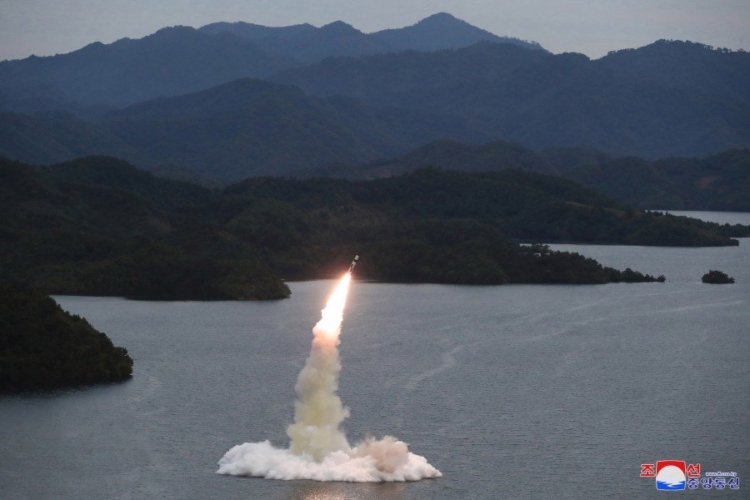
Missile Test from Taechon Reservoir: SRBM, not SLBM
Key Findings
- North Korea’s September 25 test launch of a ballistic missile from the Taechon Reservoir was a short-range ballistic missile (SRBM), not a submarine-launched ballistic missile (SLBM) as commonly reported.
- The missile used for this test appears to be a modified version of the KN-23 SRBM. The original single-stage, solid propellant KN-23 was first tested in May 2019.
- The development of silo basing (underwater or underground) for North Korea’s ballistic missiles provides no strategic or operational benefit over its existing hardened network of road-mobile, potentially rail-mobile, and submarine launch platforms.
- This launch event was an apparent effort to validate preliminary concepts for the potential development of underwater ballistic missile silos using an SRBM.
- Rather than an emerging threat, this test was most likely a propaganda and deception operation designed to focus regional and world attention on North Korea’s desired external image of a mighty and powerful nuclear-armed nation.
On October 10, 2022, North Korean media provided details of the ballistic missile launches that it had conducted between September 25 and October 9. These missile launches were designed “…to check and assess the war deterrent and nuclear counterattack capability of the country, which comes to be a severe warning to the enemies.”1 Among these launches was a unique “…ballistic missile launching drill under the simulation of loading tactical nuclear warheads at a silo under a reservoir in the northwestern part of the DPRK at dawn of September 25,” under the guidance of Kim Jong-un.2 The reservoir was subsequently identified as the Taechon-jeosuji (Taechon Reservoir, 40.002758, 125.494309) in Pyongan-bukdo (North Pyongan Province) by the South Korean Joint Chiefs of Staff.3

The North Korean media report went on to state that this particular test,
“…was aimed at confirming the order of taking tactical nuclear warheads out and transporting them and of managing them in a rapid and safe way at the time of operation, checking the reliability of the overall management system, making the units acquire launching capabilities of the ballistic missile at the underwater silos and inspecting their rapid response posture. …Through the drill, the orientation of building a planned silo beneath the reservoir was confirmed.”4


A careful reading of this statement discusses both the “…simulation [emphasis added] of loading tactical nuclear warheads at a silo under a reservoir…” and the “…building a planned silo beneath the reservoir [emphasis added].” These reports do not mention an existing underwater silo or a submarine-launched ballistic missile (SLBM) test, as commonly reported by world media. Instead, this was an apparent effort to validate preliminary concepts for the potential development of underwater ballistic missile silos using a short-range ballistic missile (SRBM). In this case, the SRBM appears to be a modified version of the KN-23 for the test. And, although not visible in any of the released imagery, there is a better-than-even chance that the launch platform was likely a small platform upon which an improvised launcher was mounted. It is unlikely that this platform was submersible or as capable as the submersible missile test barges seen at Sinpo or Nampo.

The basing of ballistic missiles in underwater silos, and their variations, is not new—it is among the numerous basing concepts explored by the superpowers and their allies during the Cold War.5 If North Korea has, in fact, validated this underwater ballistic missile silos capability, it is unclear whether they will actually pursue it to any significant degree. From all appearances, such a project comes with numerous challenges for North Korea’s over-extended ballistic missile program, including constructing and emplacing reliable waterproof silos; addressing flexible retargeting and false alarms; performing underwater maintenance or repairs; developing force structure; expanding a reliable command and control network; addressing financial and simple economic costs, etc. These factors and others are exacerbated by the challenges presented by the numerous ballistic missile systems already under development, production, or deployment.
Significantly, the development of silo basing (underwater or underground) for North Korea’s ballistic missiles provides no strategic or operational benefit over its existing hardened network of road-mobile, potentially rail-mobile, and forthcoming submarine launch platforms.
What to make of the revelations concerning the Taechon Reservoir test? It shouldn’t be completely dismissed, as it might represent the end result of some design concept by Kim himself, the Strategic Force, or a design bureau. However, it is most likely another example of a propaganda or deception operation designed to focus regional and world attention on North Korea’s desire to continue portraying itself as a mighty and powerful nuclear-armed nation.
References
- “Respected Comrade Kim Jong Un Guides Military Drills of KPA Units for Operation of Tactical Nukes,” KCNA, October 10, 2022, www.kcna.kp. ↩
- Ibid. ↩
- Go-Woon Huh. 허고운. “軍, 북한 ‘저수지 SLBM’ 발사에 “‘킬체인’ 의식한 궁여지책” (Military: North Korea’s reservoir launch of SLBM a ‘desperate measure conscious of the ‘Kill Chain’,) News1, October 11, 2022, https://www.news1.kr/articles/4828441; Kwon Hyuk-chul. “S. Korea was unable to detect North’s unprecedented SLBM launch from reservoir,” Hankyoreh, October 11, 2022, https://english.hani.co.kr/arti/english_edition/e_northkorea/1062210.html; and Jeongmin Kim. “North Korea’s lake-launched missile complicates Seoul’s defense plans,” NK News, October 11, 2022, https://www.nknews.org/2022/10/north-koreas-lake-launched-missile-complicates-seouls-defense-plans-experts/. ↩
- “Respected Comrade Kim Jong Un Guides Military Drills of KPA Units for Operation of Tactical Nukes,” KCNA, October 10, 2022, www.kcna.kp. ↩
- For example, see: Department of Defense. ICBM Basing Options, December 1980. ↩

